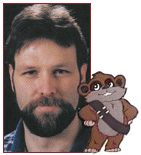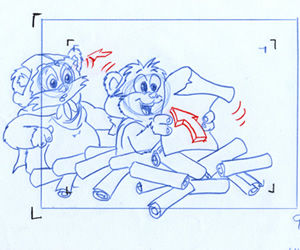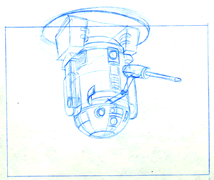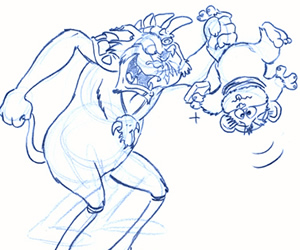
If you've ever watched the television shows the "Ewoks" or "Droids" from the mid-eighties, you probably would have witnessed the artistic talent of Mr. Brian Lemay…animator on both series for the Canadian production company, Nelvana. I have always been a fan of both Star Wars and animation, so it was only natural that some of my fondest memories (after the classic movies left the big screen) were of these Saturday morning cartoons. Today, one of my favorite niches in my Star Wars collection is my original animation artwork. While researching for my Ewok cel collection, I happened across the website of Mr. Lemay and told him of my passion for his work. To my delight, he graciously agreed to an interview, so we can all learn more about the artist and the artwork of Nelvana's "Ewoks" and "Droids" cartoon shows.
 Maureen: Thank you, Brian, for sparing some time out of your busy schedule
to answer my questions. Let's begin before the "Ewoks" and "Droids"
days. When did you first know you wanted to make animation your career?
Maureen: Thank you, Brian, for sparing some time out of your busy schedule
to answer my questions. Let's begin before the "Ewoks" and "Droids"
days. When did you first know you wanted to make animation your career?
Brian: I always liked to draw when I was a kid. I remember getting "serious" (hah) about it in Grade 3. I would copy characters like Popeye and Archie, figuring out a system for drawing the heads the same way all the time. I did my first animation in Grade 5 with an 8mm camera, a toy dump truck and G.I. Joe. My first drawn animation was in Grade 7; it was a zebra walking and his stripes falling off (I stole the idea from an Ed Nofziger book).
Maureen: Were there any cartoonists or other artists that inspired you
or whom you felt influenced your desire to enter into this field?
Brian: My earliest memories of animation were watching "Roger Ramjet" during lunch when I was in Grade 1. As I began to experiment with animation, I would sign out books about Walt Disney or cartooning books, most notably one called, "How to Draw Cartoons" by Jack Hamm. I would sign that book out of the library over and over again and just copy the drawings in it for practice. My parents bought me some of the Walter Foster books which were very helpful. I loved the drawing style in "Animals are for Fun" book by Ed Nofziger.
The biggest stylistic influence however has to go to the "Roger Ramjet" cartoons by Fred Crippen. I love the humour and timing in those cartoons.
Maureen: What educational background do you have, or perhaps even more
important, were there the resources to help young Canadian artists at the time
you were just beginning?
Brian: After Grade 12 high school I went to Sheridan College in 1977 for their animation program. I went for two years but then dropped out a month before the second year was finished to get a job at Nelvana as an in-betweener on a television special called, "Take Me Up To The Ballgame".
Maureen: I know you now teach animation; what educational advancements
have there been over the past thirty or so years since you were a student?
Brian: When I was at school the courses we took were: Animation, Drawing for Animation, Life Drawing, Visual Language, and Technical Drawing. We didn't have dedicated courses in Layout, Character Design, Storyboarding or Background Painting. We got little bits and pieces of it but nothing structured.
When I began teaching in 1988 it was just after I had been the Layout Supervisor at Atkinson's in Ottawa and Nelvana. I was looking at a lot of portfolios from the students at Sheridan and wondering, "Why weren't these people getting any structured training in Layout or Storyboarding?"
As soon as I started teaching, they asked me to set up a Layout course. I wrote the curriculum and started teaching them all the stuff they would need to know in the studio. About 50% was artistic; dealing with perspective and spatial relationships and keeping things "on model". The other 50% was all about being organized and labeling. Lots of the students complained about the labeling stuff but they always came back and thanked me when they got a job, telling me how important it was to learn that aspect.
I guess the other major thing for me at that time was the fact that there was very little in the way of instructional materials. "The Illusion of Life" had been out since 1980 and it's a great book but it didn't deal with the nuts and bolts of how to do the stuff. I decided in 1989 to write a book on Layout and use it as part of my course. As I began to teach other courses such as Character Design, I'd write a book or two on that subject as well. As of last year I have eight books written with two more in mid-production. They're being used around the world at various animation schools as part of their curriculum and several studios have used them in their training programs.
Maureen: I think it's admirable that you're passing on your knowledge
and experience to the next generation of artists. Animation tools have really
evolved with the use of the computer. Obviously this is something you use a
lot nowadays, as I have viewed many of your current projects at "The
Animated Cartoon Factory". Do you miss the hand-drawn days of old,
or do you still use a combination of old and new techniques?
Brian: I took the Maya course at Seneca College in 2002 to get a proper understanding of what the students need from an educational point of view. During that course, I produced a short 2 1/2 minute film called "It's Alive". It was fun to work on, a real pain in the butt at times. My feeling on computers has always been that a computer is like an airbrush. With it you can create images. It's a machine that you need to learn how to use properly before you can produce anything half decent with it. Ninety-nine percent of it is the idea that you have in your mind. The computer simply gives you a different style of image. Charcoal, pastels, oil paint, watercolour, pencils... they all give you a different style. If you want to make it animate, those principles are always the same. The relationship of time and distance equal speed. This principle, and any of the others such as: squash and stretch, slo-in and slo-out, overlapping action, none of these change regardless of the medium you're using.
(Maureen:
Brian was kind enough to give me a further explanation of what "slo-in"
and "slo-out" are:
"Slo-in
and slo-out are the terms used for the spacing of the drawings to each other.
The best way to describe it would be the analogy of your car. If you hop into
a car and start up the engine, when you step on the gas to go for a drive, the
car speeds up from 0 miles per hour to 60 miles per hour over a gradual period
of time. This is a slo-in. If the car went immediately from 0 mph to 60 mph,
the G-force would probably kill you or push your eyeballs into the back of your
skull. Nothing moves from a static situation to a full speed without a gradual
slo-in. Slo-out is the opposite. When you apply the brakes to your car, even
if you lock the brakes, it still takes the car time to slow down to a stop.
The only time this wouldn't apply is if your car hits a brick wall or some other
solid immovable object. Without slo-in or slo-out applied to animation, everything
would look mechanical and robotic." )
Brian: I still love to hand animate and most of the work I do is still hand animated. I think the computer has sped things up remarkably and made animation accessible to anyone within a reasonable budget. When I was first starting out, you'd need a 16mm camera stand which could cost you $20,000 if you could find one. We'd have to wait a day to get our film back from processing to see if the animation worked or not. Now you can sit in front of your computer with software like Flipbook and a webcam and watch a pencil test ten seconds after you've finished shooting it.
Just today, I did five pan background shots with multiple layers all moving at different rates in just under three hours. When I was in school, this same thing would have taken me days to complete. Even as little as five years ago I wouldn't have been able to do it in my home studio, with equipment that has cost me less than $3,000.
I don't consider the days of "hand drawn animation" as "old" by any stretch of the imagination. It's all a matter of style.
 |
Maureen: How did you first become involved in the Lucasfilm cartoons, and how long did you work on the series? I know that in the "Ewoks", the animation style changed greatly from the first season to the second and last, season.
Brian: I had finished working on the "Inspector Gadget" show in June of 1983 and took a month-long holiday in Los Angeles. When I got back to Toronto, there was nothing really happening in animation so I delivered pizza for about six months. I went into Nelvana when I heard they were hiring Layout people for "Ewoks" and "Droids". I did a layout test and got the job later that week.
I started on the "Ewoks" show as an assistant. That basically means that I cleaned up another layout artist's rough drawings. I did this for about two weeks then was promoted to layout the scenes myself. I worked on the first four shows of the first season and got really tired of drawing trees and bushes all the time. The "Droids" show started later and was just beginning to move into layout at this time and I asked to be shifted over to the "Droids" crew.
The "Droids" show was much more challenging as it had far more locations and they required perspective drawing which I really enjoy (a lot more than drawing trees, that's for sure). I worked on all 12 shows plus the special, "The Great Heep".
Many people have asked if I've ever met George Lucas, unfortunately, I haven't. I'd like to someday. We never had any direct dealings with any executives from Lucasfilm as we were basically the grunts who just did the work. I remember hearing that Micki Herman (the producer from Lucasfilm) was in the building at some point during the production but again, we never had any face-to-face encounters.
Maureen: That's too bad! During your time at Nelvana, what were your
specific duties or responsibilities on the "Ewoks" and "Droids"
shows? In other words, what exactly does a Layout Artist do?
Brian: As
layout artists, it was our responsibility to take the storyboards, character,
location, and prop designs and draw each of the elements that go into a scene.
Depending on the type of shot in the storyboard panel we would either begin
with a character pose or the background. We'd use the storyboard as a reference
for the camera angle and the actions of the character within the scene. Since
the storyboards were only about 2" x 2 ½" in size and didn't
have very much detail to them, we'd draw them at a much larger size, up to 10"
x 11" or so. We'd draw the background in pencil and as many animation poses
of the characters as was required by the action in the scene. We'd also have
to level the artwork properly for the animators. If a character was walking
in behind a spaceship, we'd draw the background behind the character on one
sheet of paper, then the character on another and finally the spaceship on a
third level that would go over top of the character.
Maureen: Were you a Star Wars fan before you became involved with the "Ewoks" and "Droids" cartoons?
|
During
the actual production I never remember saying to myself, "Wow! I'm
working on a 'Star Wars' project, this is great!"
|
Brian: Definitely. I went to the premier of Star Wars in Toronto - skipped school to go (I was in Grade 12 at the time). My friend and I made costumes for ourselves for Halloween that year, I was Luke Skywalker and my buddy was Darth Vader. He made this great costume and mask from scratch out of fiberglass and Plaster of Paris. We made our lightsabers out of flashlights and golf club tubes.
We actually went to school on Halloween day dressed up. We got to the school late and were walking down the hall to our first class when we ran into the Vice-principal. He stopped us and asked us what the heck we thought we were doing? (We didn't have a dress up day for Halloween at our school back then). He was really ticked off at us. He said, "What's your name?" and I said, "Brian Lemay, sir." Then he turned to my friend and asked, "What's your name?" In his best Darth Vader voice he replied, "I'm Darth Vader!" (and he did the hand thing at him). It was great! The Vice-principal didn't think so though and we got suspended for the day.
During the actual production I never remember saying to myself, "Wow! I'm working on a "Star Wars" project, this is great!" I just remember it was a fun job and a lot of hard work... and better than delivering pizzas in the middle of the winter!
Maureen:
That's a great story! What are your fondest memories of working on these projects?
Brian: The practical jokes we used to play on each other. There were so many of them. The best one had to be the day one of the layout guys told us his family was coming to visit him at the studio. If he was really smart he wouldn't have said anything at all. He announced to everyone that his family was visiting from China and they wanted to see where he worked. He asked us to act nicely and not do anything embarrassing, then he went downstairs to meet them and bring them back up.
In what I consider to be the greatest co-operative mobilization of a group of 20 people, about 30 seconds after he walked out of the room, I got everyone to grab everything that belonged to him including his desk, chair, all his artwork and everything that was pinned up on his wall and we moved it out onto the rooftop deck. I don't think it took us any longer than about one minute to do this, then we all scrambled back to our desks and acted busy on our layouts.
He came walking into the department and started showing his family around (they were obviously very impressed with their son's working environment). Then as he rounded the corner and gestured with his arm, he announced to them, "And this is where my desk is..."
Of course there was nothing there but a blank open space. Everyone was dead quiet. His family was looking puzzled and he was absolutely dumfounded. In a moment of sheer inspiration I walked up to him and his family and said, "Can I help you sir? I see you don't have a visitor's pass. Are you looking for someone in particular?"
He started screaming, "What are you doing to me!!!??" and we all burst out laughing... it was great!
Maureen: Ha! That's hilarious! It must have been great to work with other
talented artists, creating something together. However, I know from reading
your bio on your website
that you found the "Ewoks" project extremely monotonous… drawing
all the trees, bushes, and Endor landscapes over and over again. How else would
you and other artists break the monotony?
Brian: Other than playing practical jokes on each other all the time,
we had table top hockey tournaments during lunch or we'd go out to the local
beach and play catch or "ultimate frizbee".
Maureen: Who was your favorite Star Wars character to draw, and why?
How about the most challenging or difficult character and why?
Brian: I don't remember having any "favorite" character, maybe 3PO, he was fun to draw. R2 was the most difficult because of all the ellipses on him.
Maureen: How different was it working on "Ewoks" versus the
"Droids" series? Or were they very similar to do?
Brian: The main difference was the lack of trees in "Droids". Did I mention how much I hate drawing trees? I guess the other key difference was the lack of emotion in the characters in the "Droids" series. They always seemed to have the same emotion on their faces where as with the "Ewoks" they had lots of emotion, happy, sad, surprised, angry, the whole range.
Maureen: Can you give us an idea of the process in animating a cartoon
series? How did it develop from an idea to the final end product? Do you remember
how long it took to produce a single episode, and about how many frames of animation
a typical story required?
Brian: The overall process is the same for any series:
Script
Designs - character, prop, location
Voice recording
Storyboard
Layout
Posing
Animation
Background
Colorization (Cel painting, back then)
Camera
Sound Effects
Music
Editing
Our part of the process in layout would take about 2 - 3 weeks per show
The frame count
is always the same no matter what: each episode is 22 minutes long x 60 seconds
= 1,320 seconds x 24 frames per second = 31,680 frames. If everything was shot
on two's it would work out to 15,840 drawings. Of course there were many scenes
with more than one level of animation and some scenes with no levels of animation:
just backgrounds. (Note: to be "shot on two's" means that every
drawing of animation is exposed for two frames each. Film runs through a projector
at 24 frames a second. If you expose each drawing on two's that means you only
need 12 drawings for 1 second as opposed to shooting on one's or one drawing
every frame which would mean 24 drawings for each second.)
The "Droids" shows were huge as far as the scene count goes. I remember the average being somewhere around 380 scenes per episode. That's and average of one scene every 3.5 seconds which makes for a very fast paced show. Most other shows at that time were around 250 scenes or one scene every 5.2 seconds.
 |
Maureen: Incredible numbers; it just shows the amazing amount of artwork involved in a weekly cartoon. Can you recall anything that you learned from participating in these projects, or how this experience helped you later in your career (either positive or negative)?
Brian: The main thing I learned on these projects was organization. You have to be organized in order to get your work done efficiently. I worked out a system to be sure that I would get my quota of ten scenes a day. Sometimes that got messed up by a huge pan background or some revision to the boards.
Maureen: What projects are you currently working on?
Brian: I'm currently working on a project called "Me & Max" which I've had on a shelf now for almost 20 years. It's about a boy (Max) and his Dog (Me). The stories are told from the dog's point of view or rather through the dog's imagination. Max is an 8 year old boy who likes to go on "adventures". The dog always tags along and it doesn't take much for something to trigger the dog's imagination into going wild and taking them off into an imaginary adventure.
I recently entered it into a television contest on the CBC but was beaten out of the final round. I'm currently pitching it to a couple of animation studios and by the time this is online may have made a deal with one of them. If not, I'll find some way to get it going... I've waited 20 years so far, I don't think a few more will hurt me.
Maureen: I love "Me & Max" and voted for it on the CBC!
I would encourage our readers to check it out on your website.
It's wonderful! What would you say is your greatest accomplishment, or work
that you are most proud of?
Brian: Well, just this past February I won some goofy award... I think it's called an "Oscar" or something like that for a film called "Ryan". I did the storyboards for the film. Although I don't actually get to keep the Oscar (that goes to the Director of the film, Chris Landreth), I did get my moment of glory along with the other 75 or so people who also worked on it. The film has also won a "Genie" and about 35 other International film festival awards to date.
Maureen: Wow! An Oscar? Congratulations! What an incredible achievement! You sure have come a long way from drawing trees and bushes on Endor. What advice do you give your students, or anyone wanting to enter into the field of animation?
Brian: Talent and ability are a big part about how well you will do in the industry, (if you can't draw well, you're in trouble), but I think one of the most important things is developing good relationships with the people you work with. If you don't work well with other people, no one is going to want to work with you and you won't get hired, no matter how good you are.
The other big thing that I've learned is: right place - right time. So many things have happened just because I was in the right place at the right time. Call it "luck", "providence", "God guiding you through life", it's there and it's real. You have to keep your eyes open and seize the opportunity when it presents itself. If you sit back, it'll pass right before your eyes and you'll look back and say, "I should have done this... or that"... but you should've done something. Learning to recognize those moments is really important. Many of those moments will come to you through friends that you've worked with and built up good working relationships with.
Maureen: How very true Brian. I hope our readers can benefit from your experience. Now let's lighten the mood with some fun facts:
Favorite cartoon
of all time:
Tex Avery's: "Northwest Hounded Police". The takes throughout the
cartoon are great!
Favorite book:
I'm a voracious reader and I can't really say I have one favorite.
Favorite movie:
I love movies too and have so many favorites. I know it's goofy but there is
one specific moment in a film that is my favorite: it's in the Scarlet Pimpernel,
starring Leslie Howard and Merle Oberon. Toward the end of the film, the character
that Merle Oberon is playing comes to the realization that Leslie Howard is
actually the Scarlet Pimpernel. There's a big truck in on her face and it sends
chills up my spine every time I see it. Lots of movies have this moment in them
when the person finds out that the character they thought was a jerk, in reality
is the hero and that realization washes over them... I think that's a great
moment in a film.
Favorite hobby
or pastime:
I love to draw. I consider it a way of life and I draw whenever I can, it never
gets tiring. I like painting and sculpting my cartoon characters as well.
Maureen: Back to some more serious questions: What do you see yourself doing in 10 years?
Brian: Exactly what I'm doing now. Making cartoons and teaching other people how to do it too. I think (and I hope) I'll be doing this until the day I die. (From what I can gather about animators throughout the past 105 years, they usually live pretty long.)
Maureen: What was your favorite animation project, and why?
Brian: If I had to pick just one, I'd say "Inspector Gadget" is probably my favorite. Getting to design all the secondary characters for a series was a heck of a lot of work but it really made me grow as an artist.
Maureen: If you didn't become an animator, what do you think you would have pursued as a career?
Brian: I honestly can't and have never imagined myself doing anything else. I sometimes feel like I was born to do this.
Brian, thank you; I have learned so much and appreciate your sharing these wonderful
stories with us. I am sure you've inspired future artists to take up a career
in animation. I would encourage anyone interested in learning more to visit
Brian's website "The Animated Cartoon
Factory" at http://www.brianlemay.com. Thank you again for your contribution
to the vast Star Wars universe; it was such a pleasure speaking with you.


